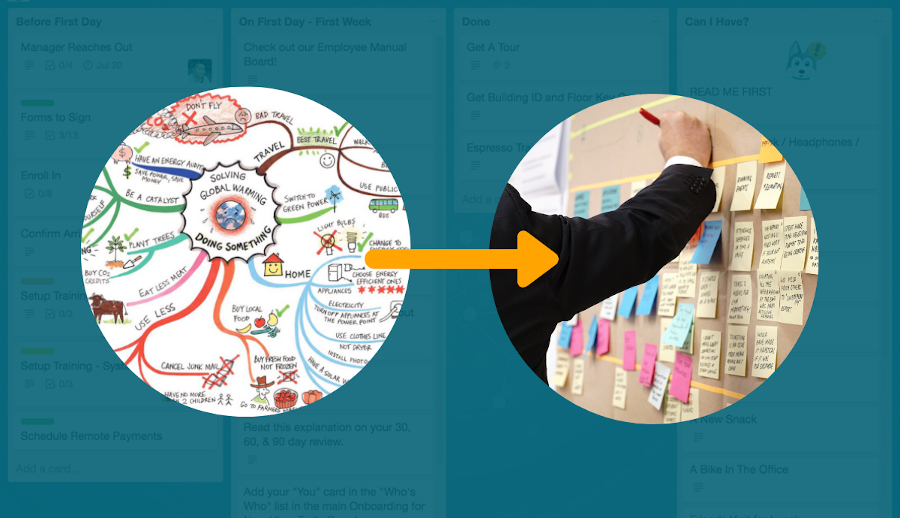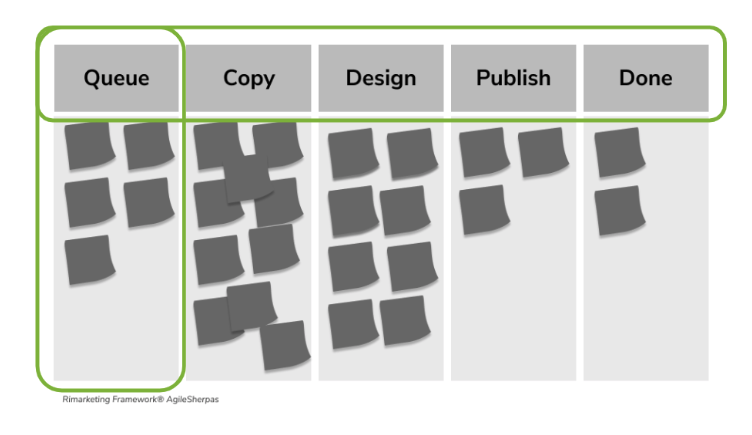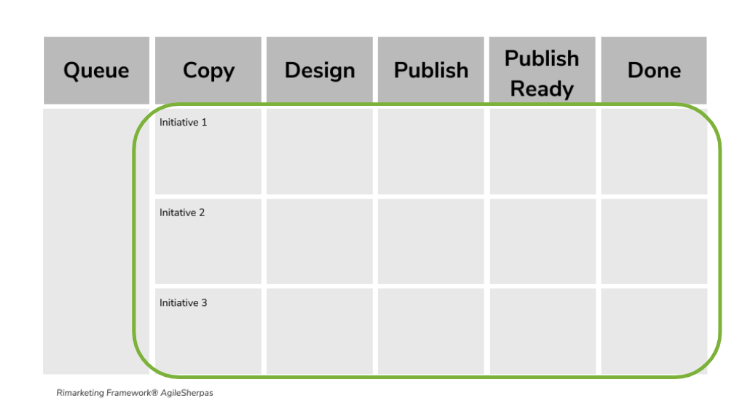
Mind mapping is a fantastic method for bringing your ideas to light and sharing them with your team. However, when it comes to prioritization, it’s not the most suitable way of organizing your workflow.
If you’ve already got a mind map in place for your ideas on the strategy level, you’re in luck, because the mind map format can effectively be translated to tracking the day-to-day task level very quickly. A high level mind map can be applied effectively with other workflow management methods for daily task management, such as Kanban, to achieve even greater impact.
What is Kanban?
Kanban is a workflow management method that relies heavily on visualization to increase productivity and facilitate process agility.
The method is widely-adopted in manufacturing and software development, and is gaining growing popularity within the marketing industry.
At its heart is the Kanban board, which is a visualization tool that resembles a whiteboard separated by vertical columns for the different process steps of a team. During the past decade, the Kanban board has become a favorite tool for teams practicing knowledge work because it provides a great deal of transparency around both team progress and individual workload.
It makes information, such as priority, task ownership, current progress, and size of all assignments, transparent to everyone with access to the board.
Similarly to a mind map, you can easily manage a Kanban board in a digital format, allowing even remote teams to interact with it effectively at a distance.
A basic Kanban board consists of three columns representing the possible states of a work item within the team:
- To do – tasks that haven’t been started
- In progress – tasks that we are actively working on
- Done – tasks that have been delivered to the customer or audience
Each team task is visualized as a card on the board with a single assignee who is responsible for it reaching Done.
This layout may seem basic. But, when your team is moving through high-value urgent or strategic work at a fast pace, this simple structure allows you to see what the team has in progress at the moment and how much work each individual contributor has in flight.
Based on your process, your team can choose to add as many columns as you need to map the steps of your workflow and gain a bird’s eye view of what is going on at every moment.
To clarify parts of your process further, you can add horizontal “swimlanes” to the board for extra transparency regarding the different types of work you do.
Streamline only the most important steps of your process on the board. This way you can have a good view of the workflow without having to spend too much time maintaining the board up to date.
For example, a typical marketing board might consist of the following steps:
- To do
- Week priority
- In progress
- Ready for review
- Review in progress
- Waiting on third party
- Done
Now that you know the fundamentals of workflow visualization with Kanban, transferring the information from your mind map to the Kanban board and starting to process it according to your current priorities should be easy.
The first step to populating your board with team work items is to turn the items on your mind map into Kanban cards. Keep in mind that because the purpose of your mind map and that of the Kanban board are different, there are some important differences about the items that you put on each of them.
While the mind map sheds light on what your plans are, the Kanban board provides visibility on how they are progressing as your team develops them. Therefore, when transferring your plans to Kanban cards, you have to turn them into actionable work items for your team and define a clear definition of “done” for them.
Prioritization with Kanban
After populating your Kanban board with tasks, the next step is to prioritize the work items. This will let your team see which work is the most important to tackle right now. As an Agile method, the Kanban format allows you to prioritize the items from your mind map in a simple way and keeps your team focused.
According to the 3rd Annual State of Agile Marketing Report by AgileSherpas, 53 percent of all marketing teams applying Agile confirm that they’ve improved the way they prioritize work since they started implementing tools like the Kanban board.
There are multiple ways to prioritize work items on a Kanban board. The most typical way is to put the most important work items at the top of the To Do column of your board, and put lower priority items closer to the bottom of the list. The lower the position, the lower the priority of the task at hand.
As a result, whenever a team member is done with their current task and considers what to start next, they just have to pull the highest possible card that corresponds to their function within the team.
Another way to prioritize work using a Kanban board is by implementing a color system. To do so, you have to define multiple types of priority, such as critical, important, normal, or low. Create a legend of these colors somewhere near the board to avoid misunderstandings and communicate clearly with your team what each color means.
With the color system in place, whenever you put a new card on the board, you just need to give it a specific color depending on the priority of the work item it represents.
Time Estimation with Kanban
During times of crisis, when different rules apply, answering the question “when will it be done?” accurately seems almost impossible. Trying to estimate delivery time using complex forecasting models brings extra pressure to managers and employees alike, especially when priorities are so volatile.
The 3rd Annual State of Agile Marketing Report found out that 60 percent of all Agile marketing teams have implemented either a digital or a physical Kanban board. It makes time estimation simple and, most importantly, current.
Use the “t-shirt size” model (e.g. “S”, “M”, “L”) to assign a relative size to each of your tasks, so you know how hard they are for the team to do. Each label can represent a time frame during which you expect the task to be completed. For example, “S” can mean 1-2 days to process, M can mean 3-4 days to process, and so on.
When considering what label to put on a task, rely on past data about how long it took to process similar work items as well as your experience within the team. These labels should be visible on the cards, to keep the estimation visible at all times. Track how many days have passed since you began working on the task as a tally on the card itself. This will give you an indication of whether your initial time estimation reflects your progress in reality.
Combined with the prioritization mechanism shown earlier, these two steps let you commit to deadlines more confidently and stay agile at the same time.
The definition of done
To keep your efficiency high, define when a task can be considered done, or “delivered to the customer.” This way, your team will avoid starting new work before completing what they’ve already started.
An accurate and clear definition of done also prevents teams from spending too much time on a task that doesn’t actually require a big investment of resources to achieve its purpose.
The simplest way to decide if something is done is to ask yourself whether you could forget about it now. To achieve this, focus on breaking down large projects into smaller tasks that take no more than a few days to complete. Once all of a project’s related tasks are done, the project itself is also considered done.
Also, it’s a good idea to include “Review” columns on your board before the Done stage. This way you’ll avoid the temptation to start new work before getting final approval of the current deliverable.
Combine mind mapping and Kanban for pristine processes
Mind mapping can be applied in symbiosis with Kanban to boost process agility and improve workflow visibility. By implementing a Kanban board in conjunction with your mindmap, you can streamline your work and make transparent the current workload of your team, along with their current progress.
In addition, you can prioritize work more effectively by placing the most important cards at the top of your list, or defining specific colors for each level of priority.
Together with the t-shirt sizing model, you can commit more confidently to deadlines and answer any questions regarding your progress more accurately.
Last but not least, agreeing on a common definition of done will allow your team to operate more efficiently and maintain agility during this troublesome time.
Have you already successfully used your mind map as a guide for building your team’s Kanban board? Share your experience in the comments below and any best practices you’ve picked up along the way.
Alex Novkov is а digital marketing strategist and consultant specializing in content marketing and search engine optimization. He has a strong background working with tech companies and has been practicing Agile since the very beginning of his marketing career. He loves creating something out of nothing and enthusiastically pursues every new project as a chance to expand his expertise.



Leave a Reply